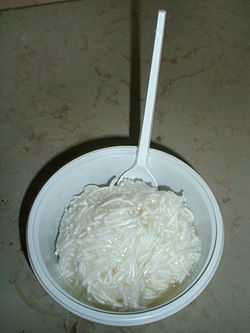Kesme
| Kesme | |
|---|---|
| Noodle | |
 A bowl of kesme in broth | |
| Alternative name(s): | |
| Kespe | |
| Main ingredient(s): | |
| Flour, water, salt, an egg | |
| Recipes at Wikibooks: | |
|
| |
| Media at Wikimedia Commons: | |
|
|
Kesme (Kyrgyz: кесме, [kesmé]) or kespe (Kazakh: кеспе, [ki̯ɘspi̯ɘ́]), Azerbaijani: Əriştə, Persian: رشته, Turkish: erişte); refers to a traditional Central Asian noodle dish made by the Kazakhs or the Kyrgyz. The word itself is a nominalisation of the verb to cut or to slice, referring to the slicing of the dough involved in preparing the noodles. The term may refer to the noodles themselves, or the prepared dish made with them. Kesme is primarily a home-made dish, and not often found at restaurants or cafés.
Reshte are Persian style noodles used in soups, mixed with rice or with deserts (Faloodeh).
Reshteh (Persian: رشته), from the Persian word for thread or string, refers to a very fine noodle similar to capellini (angel hair pasta). However, it generally means a fresh (as opposed to dry) ribbon shaped egg noodle. Traditionally the noodle would be a homemade and cut item. Reshteh was the only word used to denote noodles in Arab cookbooks of the 13th and 14th centuries. Special symbolism is given to dishes that contain noodles when a decision of importance or change is to occur; the noodles or "reins" of one's life are to be taken in hand. A traditional dish in Iran is reshteh polow or pilaf, which is served during the Persian new year with the noodles representing the threads of life and family intertwined. Noodles are used for special occasion dishes in giving thanks and for journeys especially to Mecca. Typical preparation is for the noodles to broken into parts, fried or grilled brown and then added to rice.
The reshteh used currently in the Iranian cuisine is actually a thicker type of noodle, used in reshteh polow and also a type of ash, called Ash Reshteh.
In Turkey, kesme is known as "Erişte". It is played ball in Anatolia and is eaten generally in winter.[1] It is made from flour, egg, water, salt and milk. These ingredients are worked and is turned to dough. The dough is roll out and is cut. These slices are dried in sun or fried in oven after dried for a day.[2]
Preparation
The dough for kesme is rather simple, usually consisting of no more than flour, water, salt, and an egg. The dough is rolled out into a large thin circle, and left to dry for a while. It's then lightly floured, folded over several times accordion-style, and sliced into strips. These strips are separated, and either boiled right away in a broth (often containing ingredients such as potatoes, meat, carrots, peppers, and tomatoes), or left to harden for storage and use later. Kesme is often made in a kazan.
Gallery
| Wikimedia Commons has media related to Kesme. |
-

A bowl of kesme in broth
-

Kesme noodles, laid out to dry
-

Kesme dough being cut into noodles
See also
- Lagman - A similar Central Asia noodle dish, made by stretching the dough instead of cutting it, associated with the traditionally sedentary Uyghurs and Uzbeks.
- Pasta
- Noodle
- Chinese noodles
- Cup noodles
- Frozen noodles
- Instant noodles
- Japanese noodles
- Korean noodles
- Philippine noodles (pancit)
- Shirataki noodles
- Vietnamese noodles
Davidson, Alan. Oxford Companion to Food (1999), "Reshteh", pp. 659–660.
